
Narita, Karuizawa,
Ukishima Marsh and ferry to Hokkaido
The trip was scheduled for January 30th to 17th February 2005 and began when I landed at Narita airport, south-east of Tokyo, after a 12-hour flight from the UK. I took the free bus to the Holiday Inn, on the way seeing flowering camellias and small bamboo trees. It was at the Holiday Inn that I was to meet Armas Hill of Focus on Nature Tours (FONT). He had told me to ask at the desk for him. I duly did so but the desk attendant did not understand what I wanted and tried to book me in to the hotel. I declined his offer and went to sit on one of the chairs in the foyer and see whether Armas turned up. He did say he might not be there because he would be getting our first vehicle of the trip. After a few minutes wait an American came up to me and asked if I was waiting for someone. I said who I was and so met Armas. A few minutes later we were joined by a couple from Texas, although originally from Ireland, Claire and Ian, and we sat and chatted whilst we waited for the other three people of the party to arrive. Peter was next to arrive, hailing from The Netherlands and we decided to investigate the birds of the Holiday Inn carpark. At first bit seemed quiet but soon we had a Brown Thrush and a small party of Brown-eared Bulbuls, both lifers for me. The far end of the carpark held a fine male Daurian Redstart and a Dusky Thrush flew in and out of the bamboo trees. A Black-backed Wagtail showed in a small garden and about five Japanese White-eyes called from a treetop soon to fly over our heads and away. Two birds on a telegraph wire proved to be White-eared Starlings and finally a Pale Thrush was found feeding in leaf litter beneath a row of bushes. That made eight lifers for me, all in a hotel carpark. A good start but nothing that we were not to see again.
About and hour and half after Peter arrived the last two of the group arrived: Graham and Hemme, respectively an Englishman residing in Vienna and a chap from The Netherlands. Graham told me he was somewhat surprised to see Claire, Ian and myself as he had understood he had arranged a private trip for himself and his Dutch friends.
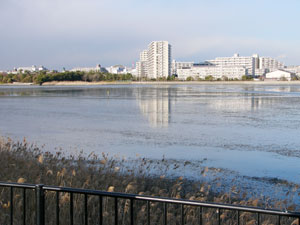
Mudflat at Yatsu Higata Park
So, we were at gathered. We loaded the van and sat in the rather cramped seats ready for the off. We were aiming for the town of Karuizawa, north-east of Tokyo, in the mountains. En route we were to stop at an area of mudflats. We got rather lost trying to find this site but, after some back-tracking, we found the place: Yatsu Hagata Park. 'Scopes up and we began to check out the mud and water. Our second taste of Japan was akin to being back home! About 250 Dunlins, three Sanderlings, two Greenshanks, 50 Grey Plovers, 200 Eurasian Wigeons, 150 Common Teals, 50 Northern Shovelers, 100 Northern Pintails and 100 Black-headed Gulls. A hint of the exotic, at least for me, was present in the form of about 100 Kentish Plovers and two Black-winged Stilts. Cormorants were examined closely and judged to be Great Cormorants, but a lone gull proved to be a Vega Gull. The most interesting sight was what looked like a Northern Pintail x Northern Shoveler hybrid.
We decided to walk to another viewing area, getting Black-backed Wagtail, Dusky Thrush and Oriental Turtle-dove on the way. We then added Grey Heron, Little Grebe, Eurasian Tree Sparrow and a Common Sandpiper. Some fleeting views of buntings were judged to be Eurasian Reed-bunting. As expected, the birds seen earlier in the carpark were seen again: Brown Thrush, Japanese White-eye, White-cheeked Starling and Brown-eared Bulbul.
Now for our roughly four-hour-drive to Karuizawa. We set off at about 4.30 and, after taking a few wrong turnings on the way and having to ask for directions, not helped by the fact that none of us spoke Japanese, reached snowy Karuizawa at about 11pm. It was then we discovered that Armas had not booked a hotel so we turned into the first one we saw, The Prince Hotel, and pulled up at the main entrance. Snow lay all around and it was pretty cold. We lurked in the hotel's reception area whilst Armas tried to negotiate a room-rate he was happy with. After half an hour or so we were taken to our cabin, which had four rooms, and quickly did the day's bird list. Then to bed after what felt like a very long day.
Dawn arrived in Karuizawa and we decided to walk around the grounds, which are pretty extensive, with cabins dotted around and quite a lot of trees. Large-billed Crow turned out to be the first bird of the day, soon followed by calling Eurasian Jay and a Hawfinch atop a tree. We stopped in a carpark to decide which way to go and I found a Japanese Pygmy Woodpecker, which kindly flew towards us and landed in a nearby tree. Here we also had Great Spotted Woodpecker, Great Tit, Oriental Greenfinch, Coal Tit and Carrion Crow. Armas suggested a short drive to a wooded are he knew, a site I believe Graham had mentioned to him, for a look for Copper Pheasant. As we drove there a town sign told us the temperature was -6°C.
We reached out site, disembarked, and left Armas to park the van. We walked slowly up the icy hill, surrounded by snow-covered, wooded slopes. Very quickly I saw a bird fly towards us and alerted the others. It fortunately landed quite close by and we were treated to good views of a superb male Pallas's Rosefinch. I think it was Graham who then spotted a pair of griseiventris Common Bullfinches, with the red only on the throat and cheeks rather than the whole breast and onto the belly. This was a beautiful pair of birds and I was very pleased to see this race. The walk up a couple of paths in the wood was pretty uneventful: Eurasian Jay, flyover Red Crossbill, Brown-eared Bulbul and a Japanese Squirrel. Although it was very cold, especially when the wind blew in our faces the rosefinch and bullfinches made it a very worthwhile stop.
Back in town we picked up three Black(-eared) Kites, then it was back to the hotel for breakfast. The hotel has small lake and on/by this we picked up 15 Yellow-nibbed (Eastern Spot-billed) Ducks (split from Spot-billed), Grey Heron and Great Egret. Of course, being birders, we sat by the window whilst eating breakfast, binoculars to hand. Peter spotted a Japanese Green Woodpecker, which showed not to badly for some, but then disappeared into the trees.
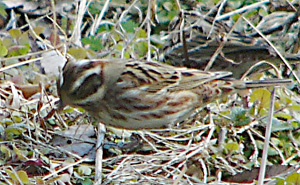
Rustic Bunting
After breakfast Armas was seen at the check-in desk and soon after we were told we were moving out of this hotel because of some problem with the room costs. Consequently we lost a fair amount of time as we drove down the mountain to find an alternative hotel. We did find a snow-free village, near our new hotel, in which we enjoyed watching a flock of about 25 Rustic Buntings and a Siberian Meadow Bunting. Driving around this area we also picked up Bull-headed Shrike and more of both buntings. A river gave us both Grey and Japanese Wagtails.
Our new hotel was nicely situated away from other habitation and surrounded by woods and steep rocky hills. As we waited in the carpark for Armas to check us in we found our first Varied Tit and Willow Tit. We decided to walk a little way down the road, which took us over stream, and soon had added Red-flanked Bluetail and Brown Dipper to the list. A nearby lake named Myogi-ko (ko means lake) added female Goosander, Mallard and Yellow-nibbed Duck but no Mandarins, a bird that stops here on migration and a few can usually be found overwintering. Not today however.
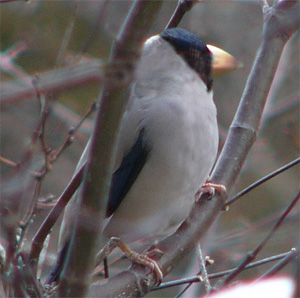
Japanese Grosbeak
We drove back up the mountain to a hotel in Karuizawa Armas knew about that had active bird feeders. We spent a very nice hour of so watching birds come to the various feeders, mostly only a few feet away from us as we watched from behind large, floor-to-ceiling-windows and drank coffee. Eurasian Tree Sparrows fed on the snowy ground along with Oriental Turtle-doves, the fat-feeders attracted Great, Willow and Varied Tits plus Eurasian Nuthatch. The bird tables, as well as the tits, attracted some great birds: Japanese Grosbeaks (three individuals) and a Japanese Accentor. We also saw a Japanese Pygmy Woodpecker, Oriental Greenfinches and a dark-looking Winter Wren.
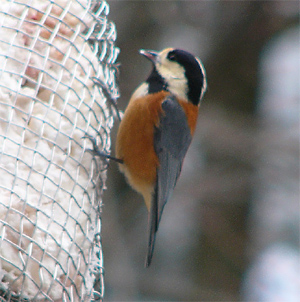
Varied Tit
Next we drove to a little-used road Armas knew of to see what birds we would come across. It was rather quiet along this road and we drove until we reached quite a steep hill. About half way up the hill the van began to slide and we had to get out. Despite pushing and trying a few more times the van would not get up this snowy hill. Funny in a way because a few other vehicles, including a coach, came past and made it up easily! They all seemed to have at least winter tyres if not snow chains, however, and many were equipped with 4-wheel drive. Perhaps Armas had failed to tell the car rental company that we would be going to the mountains? At any rate we did suggest ignoring the Drive option of the automatic gearbox and trying second and first but that was to be tried later. Graham decided to walk along the road towards the next town, getting Long-tailed Rosefinches and more Eurasian Bullfinches on the way, showing the value of walking against 'rallycross birding' from a car. At the base of the hill the rest of us found a hotel. After walking around for a while, picking up Brown Dipper on a small stream, and Bramblings, Great and Willow Tits on a birdtable by the hotel entrance, we went into the hotel (The Park Hotel) and they kindly gave us green tea as we sat at the window watching our van disappear up the road on another attempt to defeat the hill, only to reappear again a few minutes later. This went on for about three or so hours until the determined Armas used the suggested technique of dropping down to second, then first, and got the van up the hill. One of the people at the Park Hotel then kindly gave us a lift up the hill to the van. By this time it was getting dark and the (unnecessary) hotel change and getting stuck in the snow had cost us most of our only day in Karuizawa, which was a great pity. We later learned that several flocks of Baikal Teal were present in the area and had we been equipped with a more suitable van we should have had no trouble in reaching the lakes where they were spending the winter.
Next morning we did an early walk up a sometimes-very-slippery mountain path, running alongside a small river. A Red-flanked Bluetail was again found as were a pair of Eurasian Jays. After breakfast we birded around the carpark and the bridge over the stream and picked up another Japanese Accentor, a Japanese Green Woodpecker, Daurian Redstart, Varied Tit and a female Long-tailed Rosefinch.
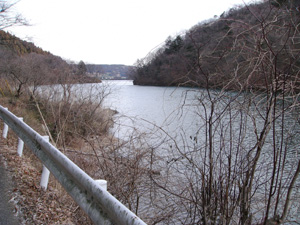
Myogi-ko
We then drove back to the lake used by Mandarins on migration. This time we found some wintering Mandarins, about 40: it was nice to see genuine wild Mandarins. Yellow-nibbed Ducks were again present along with a few Mallards. An interesting passerine caught my eye as we drove along and I shouted for Armas to stop. We reversed to the bird and Hemme identified it as a male Grey Bunting. Abandon van! The bird showed well in binoculars but was very mobile and unphotographable. After seeing this bird we were distracted when Graham spotted a Crested Kingfisher flying over the water. We tracked this bird down and Graham found it's perch in a tree above the lake – a very good-looking bird.
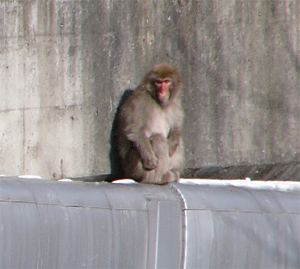
Japanese Macaque
Back in the village where we had seen the Rustic Buntings the previous day, we drove through the narrow streets and alongside orchards and fields. We picked up another 30 or so Rustic Buntings and a few Meadow Buntings plus 10 Oriental Greenfinches and a Brambling. A nearby river added another Mandarin and a Brown Dipper and we had good views of a Common Buzzard of the race japonicus, which several groups believe is a distinct species. From the van Peter spotted our first Japanese Macaque, the world's most northerly living non-human primate and one often see on wildlife programmes bathing in hot springs. We stopped to watch it and soon realised there was a large group of about 30 individuals, mostly sunning themselves on a concrete bridge. Armas dropped us off and drove off to turn around, although I don't know why. He then drove past us to turn around again in the nearby town. Nearly an hour later he came to pick us up after being stopped by the police for doing an illegal U-turn! Sadly this meant that yet more time lost in what was to become a pattern on the trip. We drove down the rest of the mountain and onto the expressway heading for Tokyo. A brief lunch stop at a service station gave us Dusky Thrush, a female Daurian Redstart, three Meadow Buntings and about 100 Eurasian Tree Sparrows.
We were aiming for Oarai where we were to catch the ferry to Tomakomai on Hokkaido. En route we stopped at Ukishima Marsh (after a brief stop by a ricefield to add Northern Lapwing to our Japan list), an area of ponds, reedbeds, farmland and a river. Here we quickly found Eastern Marsh-harriers and Buff-bellied Pipits and our first Common Coots (about 150) and two Common Moorhens. The cormorants here were mostly Temminck's with only the odd Great amongst them. Driving around the fields as the sun set we added our first Merlin, 30 Grey Herons, a Great Egret and a couple of Black (-eared) Kites. Then it was off to Oarai for our 23.59 sailing.
The night was spent onboard ship in narrow rooms with four bunks in each. Claire and Ian took one look and paid for an upgrade to a cabin!
Next morning we were on deck at dawn, 'scopes at the ready. Armas stayed in bed most of the day as he was feeling ill. Black-tailed Gulls and Slaty-backed Gulls were common as we cruised quite close to the shore. We soon discovered that the boat trip that previously went to a town in south-east Hokkaido, a route that took it over some deep water, now hugged the shore and went to a town in south-west Hokkaido. Consequently our chances of deep-water seabirds such as albatrosses was much reduced. In fact reduced to zero as we later found out!
Braving what was often freezing conditions, in blizzards or freezing rain and sea-spray, we did slowly pick up some pelagic species. Pacific Diver and Long-tailed Duck were quite easy and a couple of close auks on the water proved to be Ancient Murrelets. As we headed north we came across Common and Brünnich's Guillemots and Glaucous and Glaucous-winged Gulls. Some Pelagic Cormorants put in an appearance now and then and towards the end of the journey we added Long-billed Murrelets and Least Auklets. When on my own I had a Fork-tailed Storm-petrel fly past and later Graham also saw one of this species. Hugging the coast costs us a few hoped-for birds and we later learned that other birding groups tended to drive to Hokkaido via the recently-opened tunnel between the island and Honshu.

